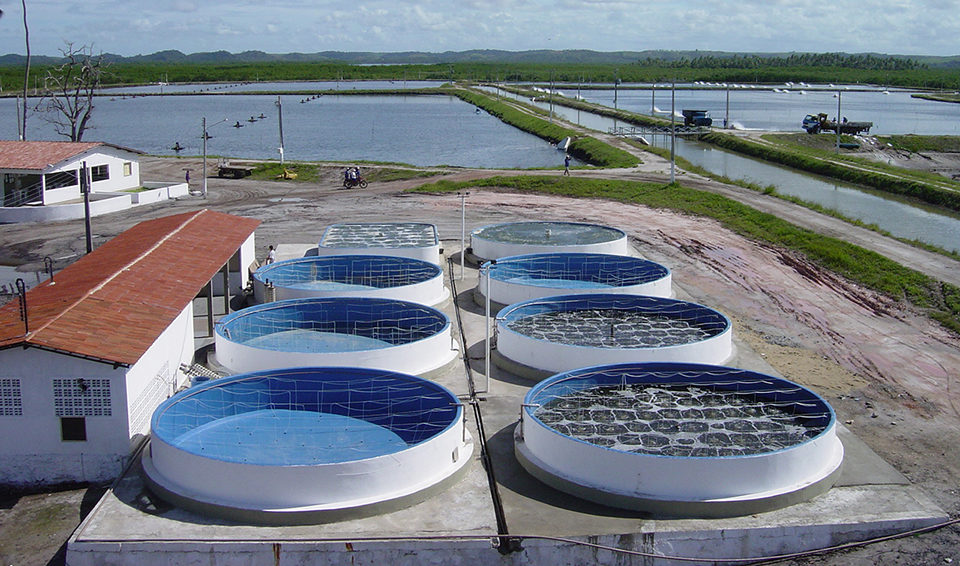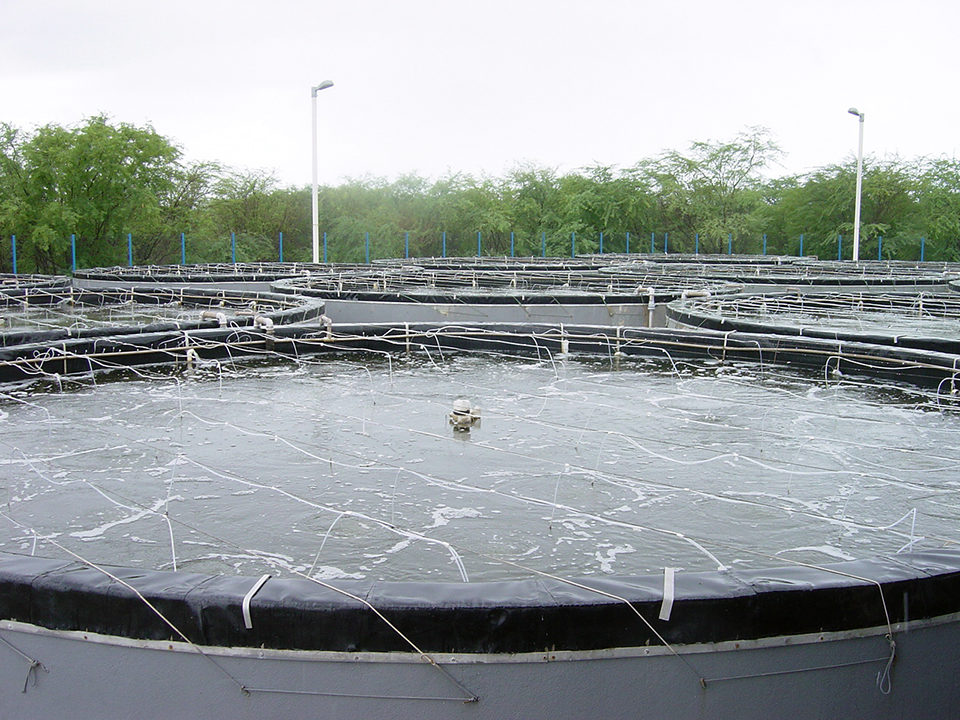Starting grow-out with larger shrimp can reduce financial risk

The conventional one-phase culture system in which postlarval shrimp are stocked directly into grow-out ponds and reared until harvest still prevails in many areas. However, with intensification and more refined techniques, the two-phase culture system has emerged. This system adopts an intermediate culture phase commonly called nursery between the hatchery phase and pond grow-out.
In the 1980s, large shrimp farms were built to operate with nursery ponds of 0.5 to 3 ha in area. Postlarval (PLs) shrimp were stocked at densities of 0.5 to 2.5 million PLs/hectare and reared four to five weeks prior to their transfer to grow-out ponds.
These culture methods modernized shrimp production strategies, as they allowed greater control and forecast of shrimp population size. However, despite the significant improvements over traditional one-phase systems, nursery ponds were expensive to build and occupied large pieces of land that could be used as grow-out area. The transfer of juvenile shrimp larger than 0.5 grams was also laborious and risky due to the stress caused by handling during harvest.
Over the years, the pioneering concept of nursery ponds evolved to smaller culture areas in hatcheries or near/within grow-out ponds at farms. Among the pen, tank and raceway nursery structures that evolved over the years, the most popular among Brazilian shrimp farms has been the intensive round nursery tanks.
Intensive nursery tanks
The intensive nursery tank concept apparently evolved from the ultra-intensive shrimp-farming system conceived in Japan in the 1970s by Dr. Kunihiko Shigueno and co-workers. Although the two systems have similarities in terms of design and engineering, the application and operational methods differ.
During the early days of shrimp farming, Shigueno’s tanks were designed to operate as a grow-out system with high water exchange rates and stocking density up to 100 shrimp per square meter. The intensive nursery tanks have been used as a tool to optimize production logistics in shrimp farms, regulating the flow of newly arrived PLs into ponds.
Nursery tanks function as temporary reservoirs for PLs that allow slow acclimation to the farm environmental conditions and provide a method for maintaining P.L. inventories and assessing their quality. Nurseries reduce the exposure of young shrimp to potential pathogens and predators, and allow early detection of health problems and diseases. They also support aggressive nutrition programs for the postlarvae.
A key advantage of nursery tanks is the possibility of starting grow-out with larger shrimp. This can reduce financial risk, shorten grow-out, increase pond turnover and eventually result in higher annual yields.

Construction, engineering
At most shrimp farms, the nursery tanks that make up the intensive nursery unit occupy 100 square meters to 0.5 hectares (ha) in area, depending on the farm PL requirements. The basic infrastructure to support the tanks is usually composed of a roofed area to protect P.L. from exposure to high temperature during acclimation and transfer; a shelter for blowers, pumps, power generator and other electrical equipment; room for feed preparation and measurement of water quality; and storage space for feed and other materials.
At farms, nursery units should be located within the operations, but preferably secluded from production ponds for biosecurity. Nurseries should be installed in locations that facilitate the uptake of clean seawater from farm water canals. Nursery tanks are usually arranged side by side and outdoors to intentionally expose postlarvae to changing weather conditions. In areas with suboptimal temperatures for shrimp culture, tanks may be built indoors for better control of water temperature.
Nursery tanks can be square, rectangular or round. Round tanks are more frequently used in Brazil and appear to have some operational advantages over other shapes. As they have no corners, round tanks accumulate less uneaten food, dead algae, sediment and other wastes. Also due to their shape, these tanks provide more uniform water circulation.
The floors of round tanks have a slight slope toward the center, where the drainage systems are mounted. Nursery tanks can be built of fiberglass, galvanized metal, laminated PVC or brick cement. Brick cement tanks may be sealed with epoxy resin or sometimes coated with a high-density polyethylene membrane. Tanks can be excavated or built over flat terrain. In both cases, the area should be free of vegetation with good circulation of air and ease of access.
Commercial nursery tanks have volumes that range from 30 to 55 cubic meters with an internal diameter of 5 to 7 meters. Tanks are designed to operate with a water depth of 1.0 meters and a maximum height of 1.2 meters. Each nursery tank is equipped with an independent water inlet and outlet system.
Water is usually pumped from pond inlet canals using an electrical pump. The pump should not be installed in shallow areas or on sites subject to high thermal variation, water stagnation or contamination from the drainage water of grow-out ponds. Water should resemble that used for shrimp grow-out and preferably be mechanically filtered using common sand filters combined with a 10-μ filter bag to remove solid materials.
Harvest of postlarvae is carried out using a chamber constructed below the level of the nursery tank floor. This allows complete water drainage and less stress on PLs. Harvest chambers are equipped with a removable ladder for access, aeration points to oxygenate water during harvest and an internal water drainage system.
To capture the shrimp, harvest water is passed through a wood or fiberglass box with a 1,000- to 2,000-μ mesh on the bottom. During harvest, the collection box is placed in a tank to allow animals to remain submerged throughout the harvest process.
For a regular supply of dissolved oxygen, nursery tanks are equipped with 5- to 10-hp air blowers. A backup power supply, such as a diesel generator with automatic switch, is critical to safely operate nursery tanks. The air systems, used for water circulation and oxygenation, are independent yet interconnected to a single valve to regulate the operating pressure and air flow.
For water aeration, PVC pipes can be interconnected and fixed to the tank floor. Pipe configurations vary from parallel to circular arrangements. Aerial aeration systems use air stones and are more popular, as they are easier to clean and maintain. Some farms use airlifts positioned around the tank walls to provide a spiral water movement within the tanks. Along with water exchange, this process assists in the concentration and removal of waste and suspended solids in the central areas of the nursery tanks.

Nursery management
In Brazil, shrimp are usually stocked in nursery tanks as 10-day-old PLs, but older animals can also be used. Shrimp may be held in nursery tanks from five days for acclimation purposes to as long as 15 days. Initial stocking densities vary 15-30 PLs per liter. Normal shrimp survival rates exceed 95 percent.
Prior to stocking, nursery tanks, hoses and air stones are disinfected with sodium hypochlorite at 20 ppm, brushed and washed with running water, and dried for 24 hours. After filling the tank with seawater, inorganic fertilizers are applied. Phytoplankton inoculation can be used when faster blooms are required.
As PLs arrive at the farm, the shrimp are acclimated to water pH, salinity and temperature in 1,000-L fiberglass tanks before stocking in the nursery tanks. When acclimation exceeds more than two hours, feed is provided.
During the nursery stage, shrimp are fed high-quality starter diets with 40 percent or more crude protein content and less than 800-μ size. Larval diets are used to minimize the risk of disease transmission. Dried feed is broadcast in the first days after stocking and then delivered in feeding trays.
Water exchange is held to no more than 10 percent a day over the first week of culture to maintain a high phytoplankton biomass. In the following days, water can be exchanged daily at 30 percent. Wastes on tank bottoms are siphoned away.
When postlarvae are ready to be transferred to grow-out ponds, their health and the presence of feed in their digestive tracts are checked. PLs should never be transferred starved or when disease or stress signs are evident. To transfer the PLs to ponds, conical 1,000-L fiberglass tanks locally known as “submarines” are used. These tanks are equipped with aeration on the bottom and can hold from 500,000 P.L.26/m3 to 800,000 P.L.20/m3 for a two-hour period.
(Editor’s Note: This article was originally published in the January/February 2011 print edition of the Global Aquaculture Advocate.)
Author
-
Alberto J.P. Nunes, Ph.D.
Instituto de Ciências do Mar
Av. da Abolição, 3207 – Mereles
Fortaleza, Ceará 60165-081 Brazil
Tagged With
Related Posts

Health & Welfare
Ammonia addition enhances microbial flocs in nursery phase for Pacific white shrimp
In a study, “pre-fertilization” in the nursery phase of a biofloc system for shrimp was tested. The objective was to accelerate the biofloc formation to minimize ammonia concentrations, avoiding high peaks during culture.

Health & Welfare
Bacillus probiotics improve hatchery, nursery production in EMS-hit Mexico
In early 2014, a trial to evaluate the effects of a mixture of Bacillus strains on early mortality syndrome bacteria during the larviculture and nursery phases for shrimp was carried out at a commercial hatchery in Mexico.

Health & Welfare
A holistic management approach to EMS
Early Mortality Syndrome has devastated farmed shrimp in Asia and Latin America. With better understanding of the pathogen and the development and improvement of novel strategies, shrimp farmers are now able to better manage the disease.

Health & Welfare
A study of Zoea-2 Syndrome in hatcheries in India, part 1
Indian shrimp hatcheries have experienced larval mortality in the zoea-2 stage, with molt deterioration and resulting in heavy mortality. Authors investigated the problem holistically.


